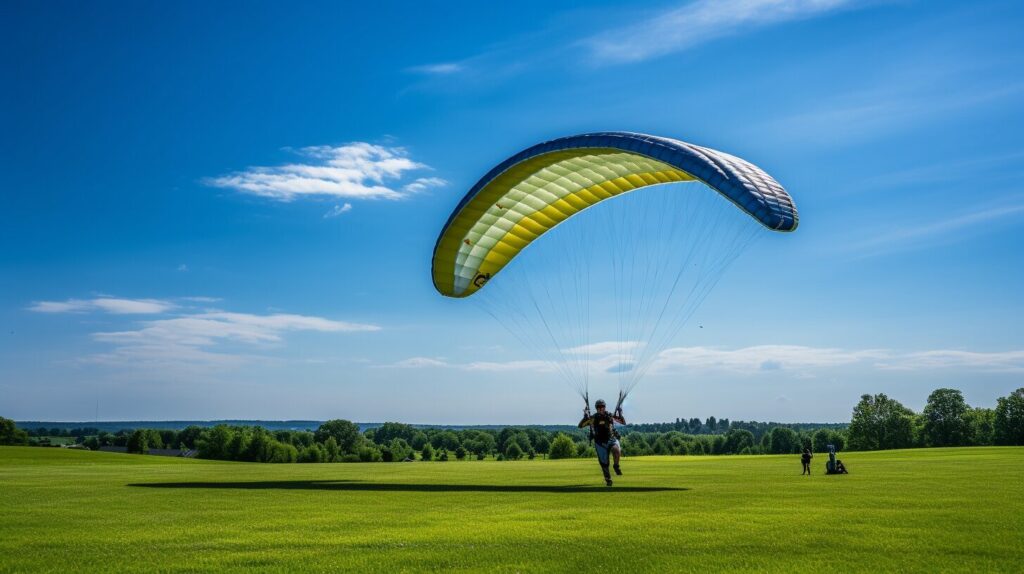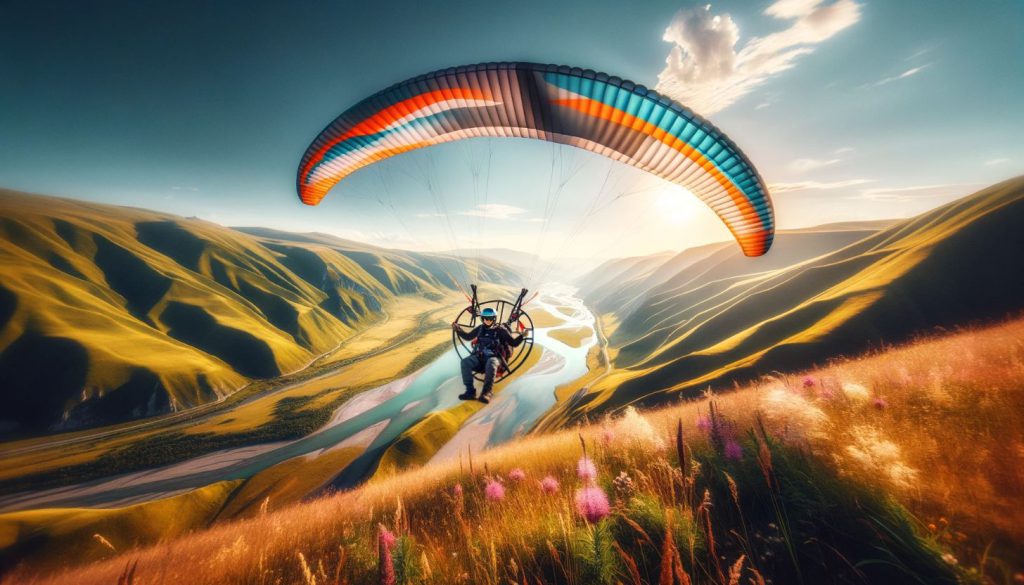If you’re looking for a thrilling way to experience the skies, paramotoring might be just what you need. As a beginner, you might feel overwhelmed by the thought of flying in a paramotor, but with the right guidance and equipment, you can master the basics and soar confidently.
In this beginner’s guide to paramotoring, we’ll provide you with essential information, tips, and techniques to help you get started on your paramotoring journey. From understanding the basics of flight physics and choosing the right equipment to launching, landing, and mastering flight maneuvers, we’ll cover everything you need to know to become a successful paramotorist.
Disclosure: When you buy through links on our site, we may earn an affiliate commission.
If you’re ready to take the plunge and explore the world from above, read on to learn more about the exciting world of paramotoring.
- Paramotoring is an exciting way to experience the freedom of the skies.
- With the right equipment and guidance, beginners can master the basics of paramotoring.
- Understanding the basics of flight physics and safety measures is crucial to a successful paramotoring experience.
- Launching, landing, and mastering flight maneuvers are essential skills for beginner paramotorists.
- There are many resources available for finding paramotoring destinations, training programs, and mentorship.
Why Choose Paramotoring?
If you’re looking for a thrilling adventure sport that allows you to soar through the skies and feel the rush of adrenaline, paramotoring is an excellent choice for beginners. Not only does it offer a unique aerial experience, but it also provides a sense of freedom and autonomy that few other activities can match.
As a beginner, you’ll learn to paramotor at your own pace, gradually building up confidence and mastering the essential skills required to handle a paramotor. Whether you’re seeking a solo adventure or looking to join a local paramotoring club, there are plenty of opportunities to explore the world of paramotoring and discover new horizons.
Beginners can expect to learn a lot from their initial flights, discovering the basics of paramotoring, and how to navigate changing weather conditions and diverse terrain. With the right equipment and training, you can quickly hone your skills and become a skilled paramotorist, mastering complex flight maneuvers and experiencing the thrill of soaring through the skies.
Paramotoring is accessible to all ages and abilities, making it an ideal choice for anyone who wants to learn to paramotor for beginners. Whether you’re looking to test your limits, explore new destinations, or simply enjoy the freedom of flight, paramotoring is an electrifying adventure sport that offers endless possibilities.

So, why wait? Sign up for a beginner’s guide to paramotoring today and discover the joys and benefits of this exciting activity.
Understanding Paramotoring Basics
Before you take to the skies and experience the thrill of paramotoring, it’s essential to understand the basics of this exciting adventure sport. At its core, paramotoring involves a lightweight motorized aircraft, known as a paramotor, coupled with a paraglider wing that enables you to fly in the air.
The wing inflates with air, creating lift that allows you to ascend into the sky and glide through the air with ease. The paramotor, worn like a backpack, serves as your engine, providing the necessary thrust to maintain altitude and control your flight path.
If you’re new to paramotoring, it’s crucial to learn the basics of flight physics, including the principles of lift, drag, and weight. You should also familiarize yourself with the essential components of a paramotor, including the frame, engine, propeller, and throttle, and how they work together to enable flight.
As you begin your paramotoring journey, remember that safety is paramount. Always adhere to proper safety measures and guidelines, including wearing appropriate safety gear and conducting regular equipment inspections. By mastering the basics and practicing safe flying habits, you can start your paramotoring adventure with confidence and excitement.

Equipment Selection
To become a successful paramotorist, having the right equipment is crucial. You don’t necessarily need the most expensive or advanced gear, but investing in reliable and durable equipment will pay off in the long run by ensuring your safety and comfort. Here’s a beginner’s checklist of essential equipment to consider:
| Equipment | Function |
|---|---|
| Paramotor | The engine-powered device that provides the thrust for your flight. Look for a lightweight and sturdy paramotor that suits your body frame and flying style. |
| Wing | The fabric structure that provides lift and control during flight. Choose a wing that is appropriate for your weight and experience level, with good stability and maneuverability. |
| Helmet and communication system | A helmet provides head protection and is required for most paramotoring activities. A communication system allows you to talk to other pilots and ground crew during flight. |
| Safety gear | Includes a reserve parachute, a backup or reserve engine, a safety harness and a comfortable seat, and other protective gear (such as gloves, boots, and goggles) to ensure maximum safety during flight. |
| Flight instruments | Includes an altimeter, a variometer, GPS, and other instruments that help you maintain your altitude, speed, and direction during flight. |
Make sure to also invest in proper storage and transport gear for your equipment, such as a paramotor bag or a car roof rack. Consider purchasing additional gear as you gain more experience and refine your preferences.
Having the right equipment is only half the battle; knowing how to use and maintain it properly is equally essential. Make sure to read the manual and follow manufacturer’s instructions carefully, as well as consult with experienced paramotorists for guidance.

Investing in the right equipment will enable you to enjoy the freedom and thrill of paramotoring while ensuring your safety and comfort.
Safety First: Pre-Flight Checks and Procedures
Before embarking on your paramotoring adventure, it’s crucial to prioritize safety and perform pre-flight checks and procedures. Here are the steps you should follow:
- Inspect Equipment: Check your paramotor, wing, and harness for any damages or wear and tear. Ensure all components are properly attached and secured.
- Assess Weather Conditions: Evaluate the weather forecast, wind speed, and direction, and avoid flying in adverse conditions such as gusty winds or thunderstorms.
- Understand Airspace Regulations: Research the local airspace regulations and restrictions, such as no-fly zones, and ensure you have the necessary permits or licenses if required.
- Wear Proper Safety Gear: Always wear a helmet, appropriate clothing, and any other safety gear such as gloves or arm guards to protect yourself from injury.
- Communicate with others: Inform someone of your flight plan, including your departure and arrival time, destination, and contact information, in case of any emergencies.
- Perform Ground Checks: Practice ground handling to assess the wing’s inflation, control responsiveness, and steering accuracy before takeoff.
By following these safety precautions and procedures, you’ll be well-equipped to handle unexpected situations and ensure a safe paramotoring experience.

Launching and Landing Techniques for Beginners
Launching and landing are critical aspects of paramotoring, and mastering these techniques is essential for any beginner. There are several critical steps to follow to ensure a safe and smooth takeoff and landing.
Clear the Launch and Landing Area
Before beginning your takeoff, ensure that the launch area is free of any obstacles, including rocks, trees, and power lines. The same goes for the landing area. Ensure that the landing zone is clear of any hazards and is a suitable flat surface.
Preflight Check
Perform a thorough preflight check of your equipment, including your paramotor and wing. Check the harness, carabiners, lines, and reserve to make sure everything is correctly attached and secure.
Wing Positioning
Once you are ready to take off, position the wing facing into the wind and secure it in place. The wing should be fully inflated and steady, with no twists or entanglements in the lines.
Running Takeoff
One of the most common techniques for launching is the running takeoff. Begin running forward towards the wind while keeping your eyes on the wing, using the throttle to gain lift. As soon as you feel the lift, continue running until airborne. Keep the wing level and maintain a steady speed until you reach cruising altitude.
Flaring Landing
The flaring landing is the most common technique used for landing. As you approach the landing area, reduce your speed and altitude while maintaining level wings. A few feet above the ground, flare your wing by pulling down on the brakes to decelerate and soften your landing.
Avoid Common Mistakes
Keep in mind that launching and landing techniques can differ depending on wind conditions, equipment type, and experience level, so avoid taking unnecessary risks. Avoid making any sudden movements or jerky motions that could destabilize the wing. Maintain complete control and stay alert throughout the flight.
Remember, practicing launching and landing techniques is crucial for mastering paramotoring. Don’t be afraid to ask for help from experienced paramotorists, instructors, or join a training program to perfect these skills.

Keep in mind that paramotoring is an extreme sport that requires proper training and skilled techniques. With a little patience, practice, and safety awareness, anyone can learn to paramotor and experience the thrill of flying.
Mastering Flight Maneuvers as a Beginner Paramotorist
As you become more comfortable with the basics of paramotoring, it’s time to start practicing some flight maneuvers to refine your skills. Here are some beginner-friendly techniques to help you master your paramotoring:
- Turning: To turn your paramotor, shift your weight to one side while simultaneously applying more throttle to the opposite side. This will cause your wing to tip and initiate a turn. Be sure to keep your weight balanced in the harness and avoid overcorrecting.
- Climbing and descending: To climb, reduce your speed and increase the angle of attack on your wing by pulling on the brakes. To descend, increase your speed and release some brake tension. Practice varying your speed and brake pressure to maintain a stable altitude.
- Staying stable: Maintaining a stable and level flight is essential for safe and enjoyable paramotoring. Keep your weight centered in the harness, adjust your throttle and brake inputs as needed, and constantly scan the horizon for any obstacles or changes in wind direction.
Remember to start slow and gradually build up your skills with each flight. Practice these maneuvers in calm weather conditions and always prioritize safety over performance.

Top Paramotoring Destinations for Beginners
If you’re a beginner to paramotoring, it’s essential to choose the right location to learn and enjoy the sport. Here are some of the best paramotoring destinations that cater to newcomers:
The Midwest
The Midwest region of the United States boasts several fantastic paramotoring destinations, including Michigan, Wisconsin, and Illinois. These states offer plenty of open spaces, moderate weather, and scenic landscapes that are ideal for beginners to hone their skills. Moreover, you can find local training schools and clubs that provide an excellent platform to learn and connect with the paramotoring community.

Florida is another top choice for beginner paramotorists. The mild climate, beautiful beaches, and abundant airspace make it an attractive destination for those looking to enjoy the thrill of flying. There are many paramotoring schools in Florida that cater to beginners and offer courses specifically designed for newcomers.
Arizona
Arizona is known for its expansive deserts, stunning natural beauty, and favorable weather conditions, which makes it an excellent destination for paramotoring. As a beginner, you can visit one of the popular paramotoring schools in the state to learn the ropes and explore the scenic landscapes from above.
North Carolina
North Carolina is a prime location for paramotorists, thanks to its diverse topography and gorgeous landscapes. The rolling hills, lush forests, and scenic coastline are ideal for beginners who want to experience the joys of flying while taking in breathtaking views. Additionally, there are several paramotoring schools in the state that offer training courses and access to local clubs to connect with fellow enthusiasts.
These are just a few of the many destinations in the United States that cater to beginner paramotorists. Before choosing a destination, do your research, and ensure it aligns with your skill level and preferences. By selecting the right location and connecting with local clubs and schools, you can kickstart your paramotoring journey and begin experiencing the thrill of flight.
Tips for Enhancing Paramotoring
As a beginner, the thrill of flying through the skies on a motorized paraglider is unlike anything else. But to truly master the art of paramotoring, it’s important to continuously hone your skills. Here are some tips for enhancing your paramotoring abilities:
- Maintain physical fitness: Paramotoring can be a physically demanding sport, so it’s essential to stay in good shape. Incorporate exercises that strengthen your core, back, and arms, such as planks, pull-ups, and push-ups. Cardiovascular endurance is also crucial, so consider adding running, cycling, or swimming to your workout routine.
- Practice ground handling: Ground handling is the art of controlling your wing while on the ground, which is crucial for takeoff and landing. Practicing your ground handling skills can improve your launch and landing technique, as well as your overall control of the wing.
- Join training programs: Many paramotoring clubs and schools offer training programs for beginners. Enroll in a course to learn from experienced instructors and get feedback on your technique. You can also meet other paramotorists and build a network of like-minded individuals.
- Seek mentorship: Finding an experienced mentor can be a valuable resource for improving your skills. A mentor can provide guidance and support, answering any questions you may have and helping you to progress as a paramotorist.
Remember, safety should always be a top priority when paramotoring. By continuously learning and improving your skills, you can enhance your abilities, build confidence, and enjoy the freedom of flight to the fullest.

Troubleshooting Common Issues
As a beginner paramotorist, you may encounter some challenges while you’re learning to fly. Fortunately, most of these challenges are easy to overcome with some preparation and practice. Here are some common problems that you may experience and how to troubleshoot them.
Wing Collapses
Wing collapses can occur when flying in turbulent weather conditions or when executing sharp turns. If you experience a wing collapse, remain calm and follow these steps:
- Release the throttle
- Use weight shift to level the wing
- Apply throttle again gradually
Practice recovering from wing collapses during training sessions to prepare yourself for similar incidents in the future.
Engine Problems
If your paramotor engine suddenly stops while you’re flying, quickly assess the situation and aim to land safely. Potential causes for engine failure could be fuel or oil supply problems, spark plug malfunction, or an overheated engine. Ensure you follow the manufacturer’s recommendations for regular maintenance and inspection to reduce the likelihood of engine failure.
Challenging Weather Conditions
When it comes to flying, weather conditions play a significant role in determining your overall safety and the quality of your flying experience. Always check weather forecasts before flying, and avoid flying in gusty or turbulent conditions. Consult with experienced paramotorists or instructors for tips on navigating weather changes and staying safe during flight.
Remember that safety is paramount when it comes to paramotoring, and you should always prioritize your safety over taking risks. If you’re unsure about anything regarding your flight, consult with experienced paramotorists or instructors who can guide you through your challenge.

Conclusion
What an adventure you have ahead! As a beginner paramotorist, an exciting new world of flight and freedom awaits. With the guidance provided in this guide, you now have the fundamental knowledge to take to the skies safely and confidently.
Follow your curiosity, challenge yourself, and connect with fellow aviators. Most of all, embrace the childlike wonder of your first flights. Soon the whispers of doubt will be drowned out by the sound of wind sweeping past as you soar.
Paramotoring is more than a hobby – it’s the realization of your wildest dreams. The sky is no longer the limit. Let your journey begin!
FAQ
What is paramotoring?
Paramotoring is a form of powered paragliding, where a motorized backpack called a paramotor is used to propel a paraglider into the air. It combines the freedom of flying with the excitement of powered flight.
Is paramotoring safe for beginners?
Paramotoring can be safe for beginners if proper training, equipment, and safety measures are followed. It is essential to undergo a certified paramotor training course and always adhere to recommended safety guidelines to minimize risks.
Do I need a license to paramotor?
In many countries, paramotoring falls under the category of ultralight or microlight aircraft, which may require a license or certification. It is crucial to check with your local aviation authority to understand the legal requirements for paramotoring in your area.
How long does it take to learn paramotoring?
The duration required to learn paramotoring can vary depending on individual progress, weather conditions, and training programs. Generally, it takes several days to a few weeks to acquire the necessary skills and knowledge to safely paramotor on your own.
How much does paramotoring equipment cost?
The cost of paramotoring equipment can vary based on brand, quality, and additional accessories. On average, a complete paramotor setup can range from $5,000 to $12,000 or more. It is important to invest in reliable and certified equipment for safety and performance.
Can I paramotor alone or do I need a buddy?
While it is possible to paramotor alone once you have gained the necessary skills and experience, it is recommended to fly with a buddy or within a group, especially as a beginner. Flying in pairs or with experienced paramotorists can enhance safety and provide support in case of emergencies.
What type of weather conditions are suitable for paramotoring?
Ideal weather conditions for paramotoring include calm winds, clear skies, and stable atmospheric conditions. It is important to avoid flying in strong winds, thunderstorms, or turbulent weather, as they can pose significant risks to your safety.
Can I paramotor at any location?
Paramotoring is subject to airspace regulations and restrictions, so it is necessary to understand and comply with the local laws and permissions. Some areas may have specific restrictions on flying near airports, cities, or wildlife reserves, so it is important to research and plan your flights accordingly.
Do I need to be physically fit to paramotor?
While paramotoring does require a certain level of physical fitness, it is not an extreme sport that demands exceptional strength or endurance. Basic fitness, flexibility, and coordination are important to handle the equipment and maintain control during flights. It is advisable to consult with a medical professional if you have any pre-existing health conditions.
Can I paramotor at night?
Paramotoring at night or in low-light conditions is possible, but it requires additional training, specialized equipment, and adherence to specific regulations. Night flying can offer a unique and serene experience, but it is crucial to prioritize safety and visibility during nocturnal paramotoring activities.




